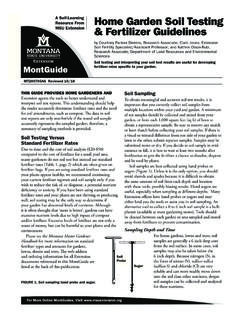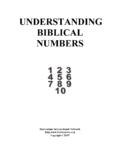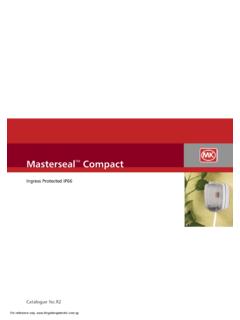Transcription of INTRODUCTION: HOW ELECTRICITY WORKS - …
1 ELECTRICITY (E) ELECTRICITY how it WORKS , how we measure and pay for it. introduction : HOW ELECTRICITY WORKS : E completely surrounds us. Modern life would be rather primitive without it. A few examples are: Outlets where you can plug in all sorts of electric appliances. Battery powered or DC devices/radios, I pods, computers. Thunderstorms releasing lightening. The static electric charge on the human body dissipates in a spark on the surface of a pet or door knob with a different charge. So, what is this mysterious stuff that we call E? Where does it come from? Where does it go and why is it able to do so many different things? BASICS: E starts with electrons. Every atom contains one or more electrons. Each electron has a negative charge. All materials are made of atoms, in some the electrons are tightly bound to the atoms, such as wood, glass, plastic, ceramic, air and cotton. These are all examples of material in which the electrons stick with their atoms very tightly.
2 Because the electrons will not move, these materials cannot conduct E very well, if at all. These materials are electrical insulators in contrast to other materials which have electrons that can detach from their atoms and move around. These are called free electrons . Metals, gold, silver, copper, aluminum, iron, etc. all have freely movable electrons. The loose electrons make it easy for ELECTRICITY , or the electrons, to move or flow through these materials so they are known as electrical conductors. They conduct ELECTRICITY . The moving electrons transmit electrical energy from one point to another. E needs a conductor or path in order to move. There also has to be a reason or force to make the electron want to move from one point to another. One way to get electrons to flow is to use a generator or push them by passing an electromagnetic field over the material, which will motivate the electrons to move. GENERATORS: A generator uses a magnet and its fields to get electrons moving.
3 There is an inseparable link between ELECTRICITY and magnetism. If an electron moves, it creates a magnetic field. If a magnetic field moves near an electron, it makes the electron move. This interaction is how a generator creates E. If you allow electrons to move through a wire, they will create a magnetic field around the wire. Similarly, if you move the magnet near the wire, the magnetic field will cause electrons in the wire to move. The generator is a simple device that moves the magnet near a wire to create a steady flow of electrons in the wire. One simple way to think about a generator is to imagine it acting like a pump, pushing water along. Instead of pushing water, however, a generator uses a magnet to push electrons along. This is a slight over-simplification, but it is nonetheless a very useful analogy. There are two things that a water pump can do with water. A water pump moves a certain number of water molecules, A water pump applies certain of pressure to the water molecules in the same way a magnet does in a generator.
4 1. Can push a certain number of electrons along (amperage or current, I). 2. Apply a certain amount of pressure to the electrons (voltage, V). 3. The size and resistance of the pipe will be discussed later (resistance, r). In an electric circuit, the number of electrons that can be moved is called amperage or the current and it is measured in amps. The pressure pushing the electrons along is called voltage and is measured in volts. So, you might hear someone say, if you spin this generator at 1,000 rpms, it can produce 1 amp at 6 volts. One amp is the number of electrons moving (1 amp physically means that x 10 to the 18th electrons move thru a wire every second) and the voltage is the amount of pressure behind those electrons. Now, let us take closer look at an electronic circuit. Electrical Circuits Whether you are using a battery, a fuel cell to produce ELECTRICITY , there are three things that are always the same. 1. A source of ELECTRICITY will have two terminals, a positive terminal and a negative terminal.
5 The source of ELECTRICITY (whether it is a generator or battery, etc) will want to push electrons out of its negative terminal at a certain voltage. For example, a AA battery typically wants to push electrons out at volts. 2. The electrons will need to flow from the negative terminal to the positive terminal through a copper wire or some other conducting material. 3. When there is a path that goes from the negative to the positive terminal, you have a circuit and electrons can flow through the wire. You can place a load of any type, light bulb, motor, TV, etc. in the middle of the circuit. The source of ELECTRICITY will power the load and the load will do its thing (create lights, spin as a shaft, generate moving pictures, etc.) Electrical circuits can get quite complex, but at the simplest level, we always have a source of ELECTRICITY (a battery, etc), a load (a light bulb, motor, etc.) and two wires to carry ELECTRICITY between the battery and the load. Electrons move from the source through the load and back to the source or home.
6 Moving electrons have energy. As the electrons move from one point to another, they can do work . In an incandescent light bulb for example, the energy of the electrons is used to create heat and the heat, in turn, creates light. In an electrical motor, the energy in the electron creates a magnetic field, and this field can interact with other magnets through magnetic attraction and repulsion to create motion. Each electric appliance harnesses the energy of electrons in some way to create the useful side effect (motion). Now that you know what ELECTRICITY is and how it WORKS on a basic level, let s learn more about some of the concepts associated with it, such as voltage, current and resistance. VOLTAGE, CURRENT AND RESISTANCE: If you live in the United States the power outlets in the wall of your house or apartment are delivering 120 volts. Imagine that you plug a space heater into the wall outlet. You measure the amount of current flowing from the wall outlet to the heater and the amp-meter shows it is 10 amps.
7 That means that it is a 1200 watt heater, volts x amps equal s watts. So, 120 volts x 10 amps equal 1200 watts. This is the same for any electric appliance. If you plug in a toaster and it draws 5 amps, it is a 600 watt toaster because 5 x 120 equals 600. If you plug in a light and it draws half of an amp or into a 120 volt socket, it is a 60 watt light bulb, x 120 volts equals 60 watts. Let s say that you turn on your heater, you go outside and you look at the power meter. The purpose of the power meter is to measure the amounts of ELECTRICITY flowing into your house so that the power company can keep accurate records of the amount of ELECTRICITY for which they bill you. Let s assume that nothing else in the house is on so that meter is measuring only the ELECTRICITY used by the space heater. Your space heater is using 1200 watts. That is kilowatts. That is simply the difference between watts and kilowatts. One kilowatt is the same as 1000 watts. If you leave the space heater on for one hour, you will use kilowatt hours of electric power.
8 If your power company charges you 10 cents per kilowatt hour, then the power company will charge you 12 cents for every hour that you leave your space heater on. kilowatts or 1200 watts x one hour equals kilowatt hours. kilowatt hours x 10 cents per kilowatt hour equals 12 cents. Similarly, if you have an 100 watt light bulb and you leave it on for 10 hours, the light will consume 1 kilowatt hour. 100 watts times 10 hours equals 1 kilowatt hour. If you have a 20,000 watt heat pump and you leave it on for 5 hours every day, you will consume 100 kilowatt hours per day (20 kilowatts x 5 hours equals 100 kilowatt hours or $ of power per day in cost, if a kilowatt hour costs 10 cents.) If you do that for one month, your heat pump cost will be 30 days x $ or $ per month. That is why your electric bill can get so much higher when the temperature is very low or very high. The three most basic units of ELECTRICITY are: voltage (V), current (I) and resistance (r).
9 As discussed previously, voltage is a measure of volts and current is a measure in amps. Resistance is measured in ohms. You can extend the water analogy a bit further to understand resistance, which is measured in ohms. Voltage is equivalent to the water pressure, the current is equivalent to the flow rate, and resistance is like the pipe size and resistance to flow. There is a basic equation in electrical engineering that states how the three terms relate. It says that current is equal to the voltage divided by the resistance, I = V/r. Let s say you have a tank of pressurized water connected to a hose that you are using to water the garden. What happens if you increase the pressure in the tank? You probably can guess. This makes more water come out of the hose. The same is true of an electrical system. Increasing the voltage will make more current flow, or electrons flow. Let s say you increase the diameter of the hose and all the fittings to the tank. You probably guessed that this also makes more water come out of the hose.
10 This is like decreasing the resistance in an electrical system, which allows an increase in the current flow. This is also where different materials demonstrate high and low resistance, wood, aluminum, copper, steel, etc. Each one has it own ability to resist or enhance electron flow. When you look at a normal incandescent light bulb, you can physically see the water analogy in action. The filament of the light bulb is an extremely thin wire. This thin wire resists the flow of electrons. You can calculate the resistance in the wire with an resistance equation. Let s say you have 120 watt light bulb plugged into a wall socket of 120 volts. The voltage is 120V and the 120 watt bulb has 1 amp flowing through it (one Amp x 120 v equal 120 watt bulb). You can calculate the resistance of the filament by rearranging the equation. r=V/I ?=120/1. So the resistance is 120 ohms. If it is a 60 watt light bulb, the resistance is 240 ohms. (?=120 ) Beyond these core electronic concepts, there is a practical distinction that happens in the area of current.



